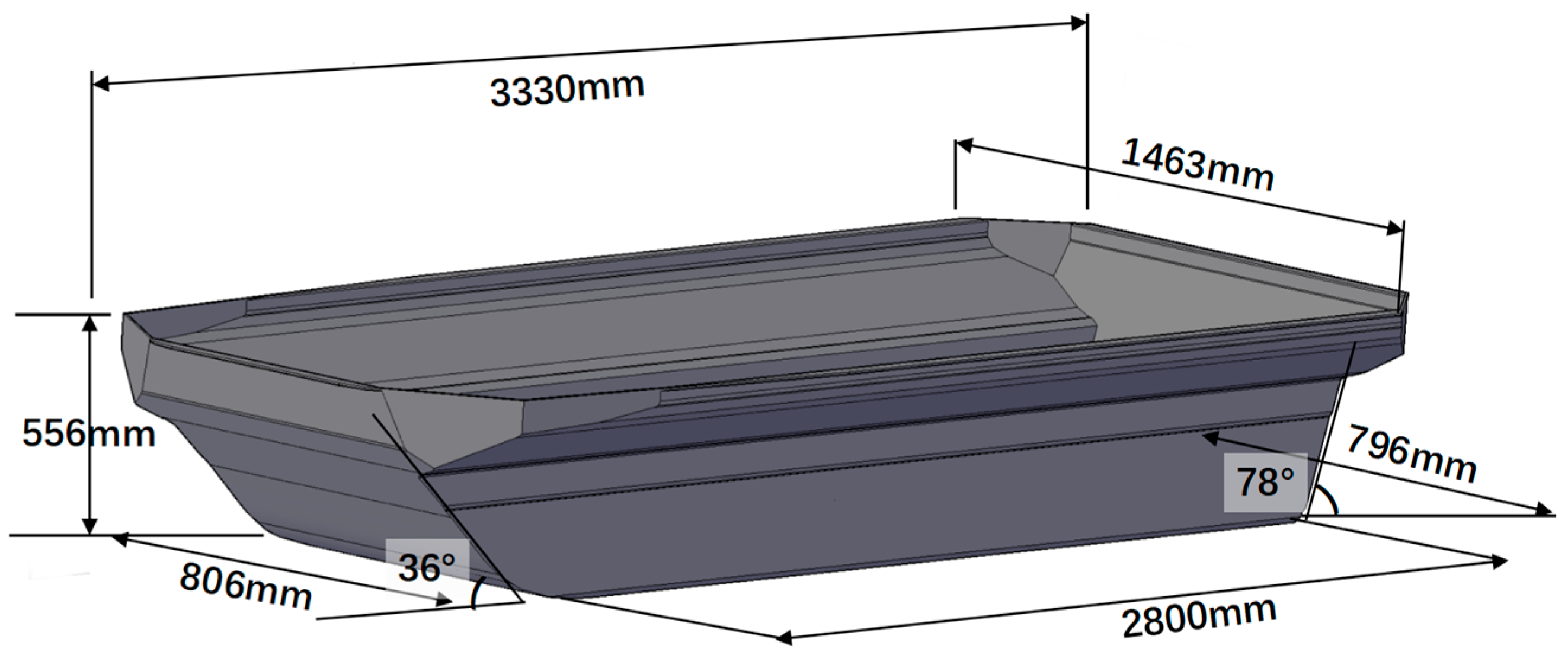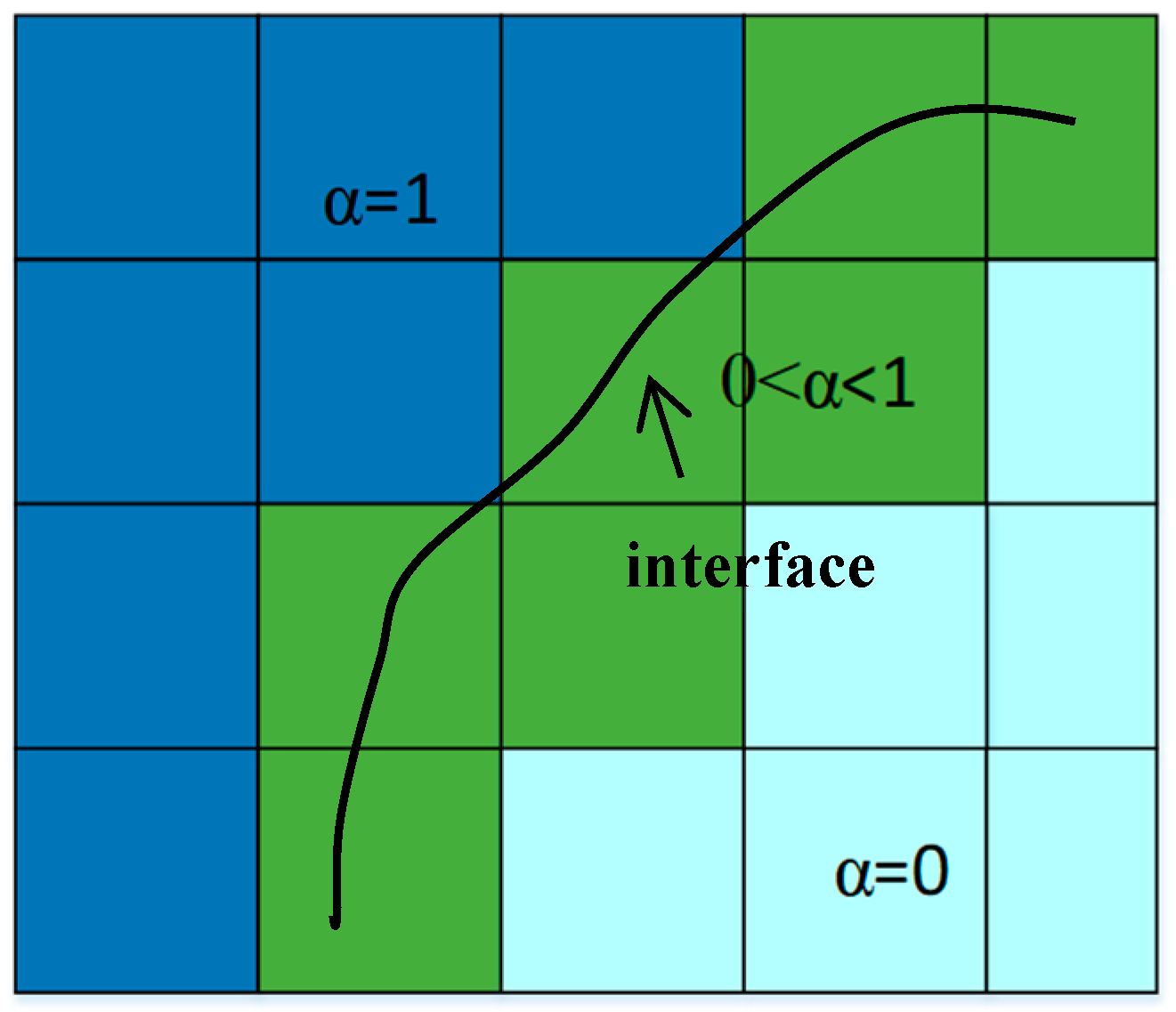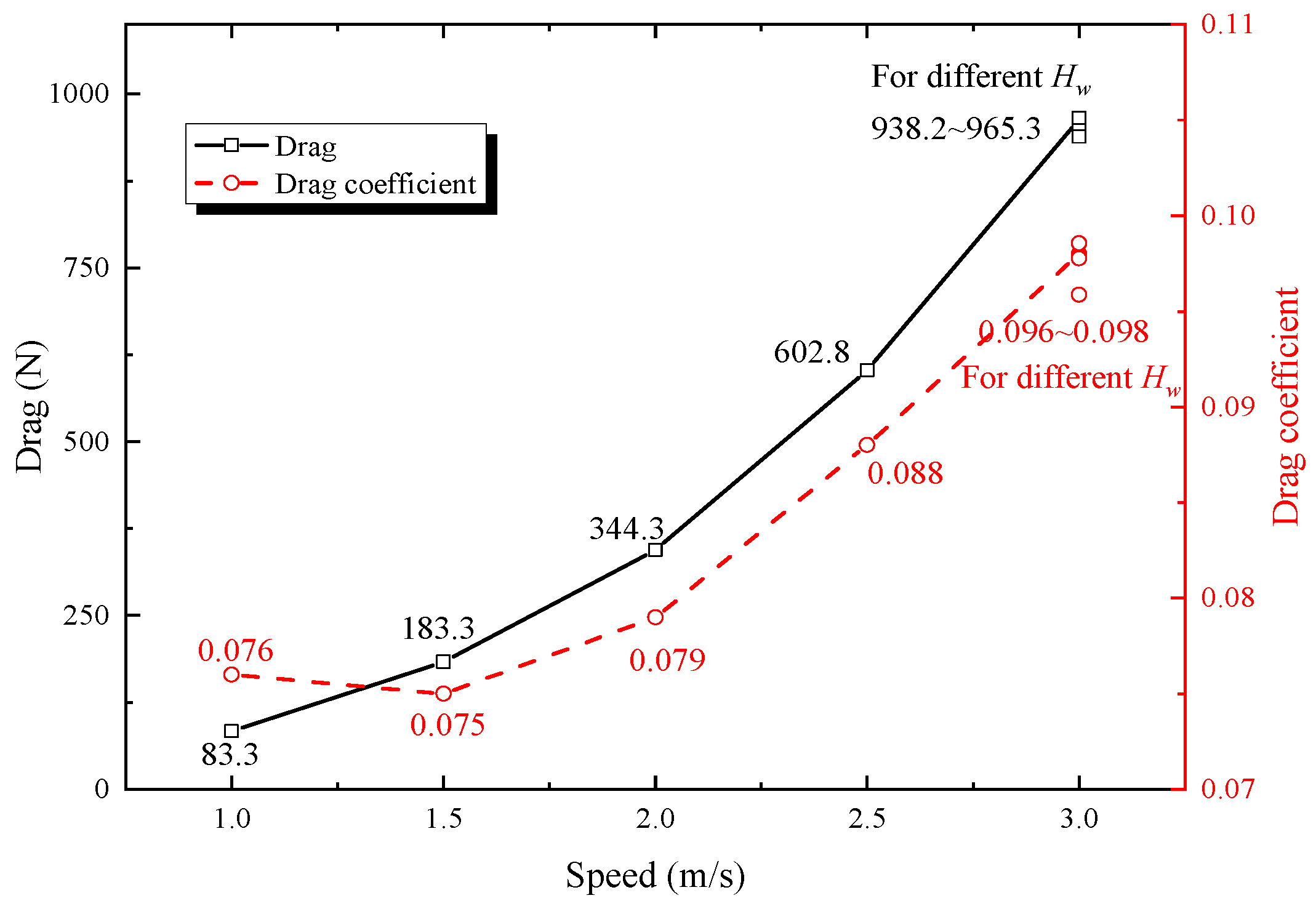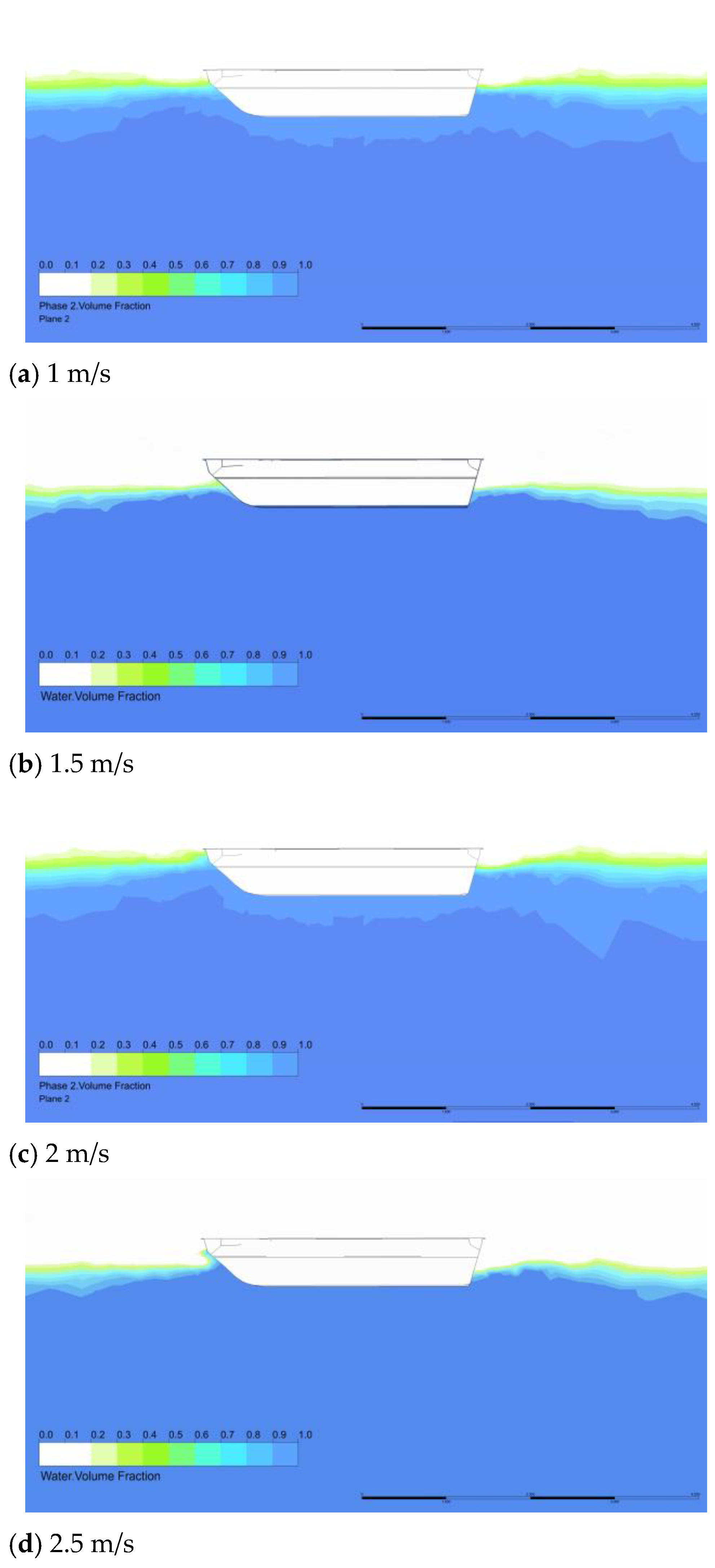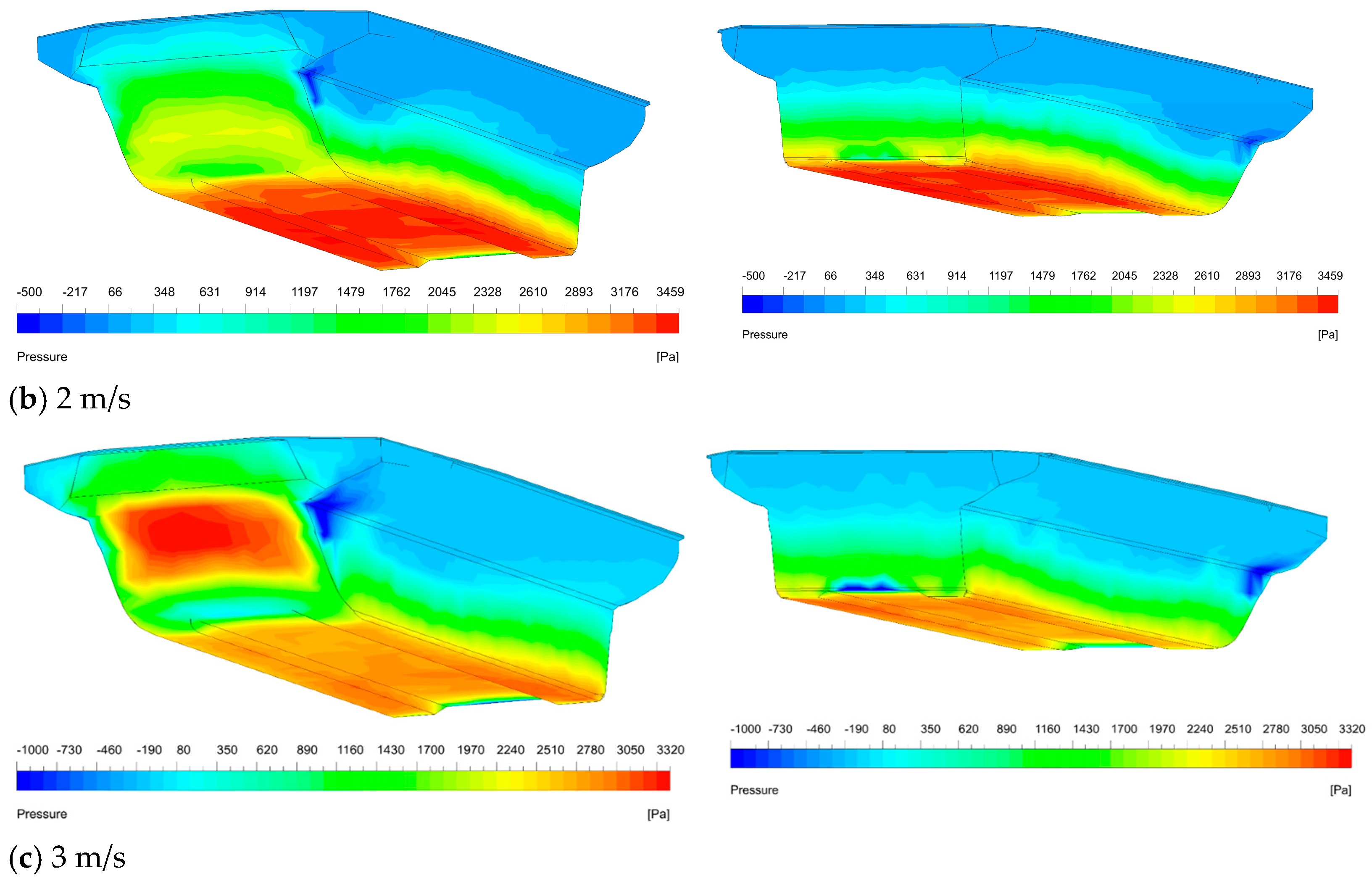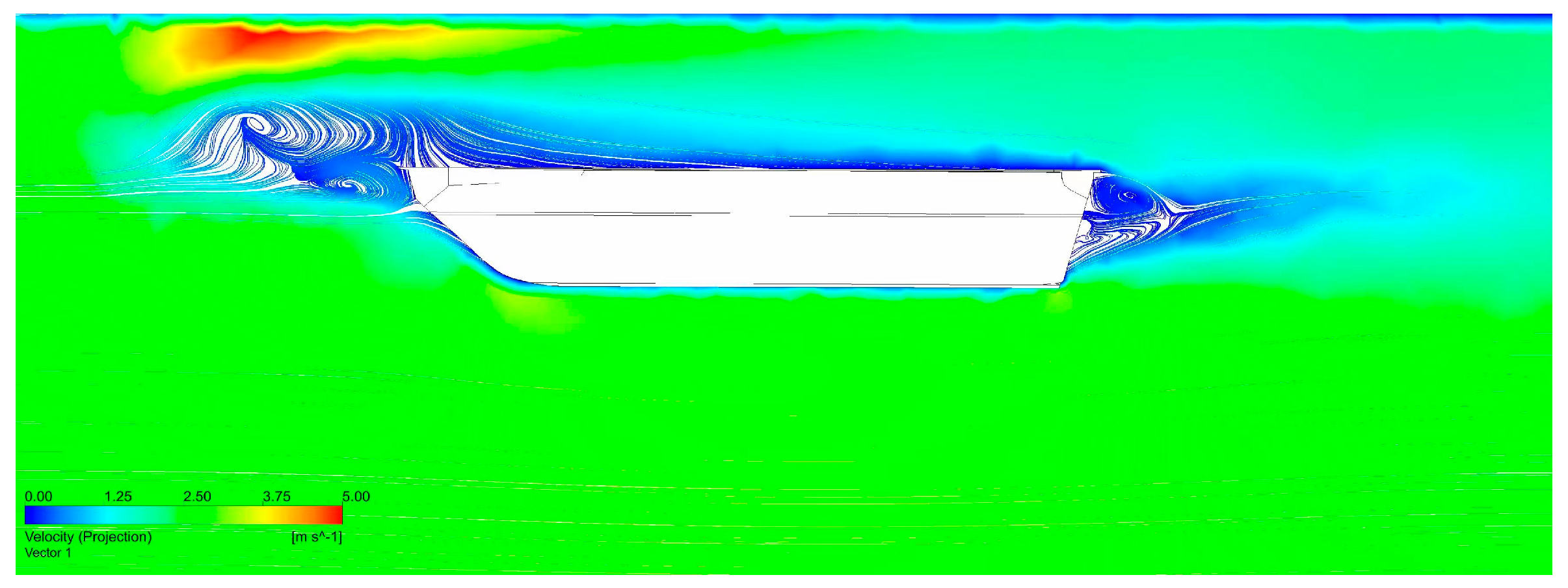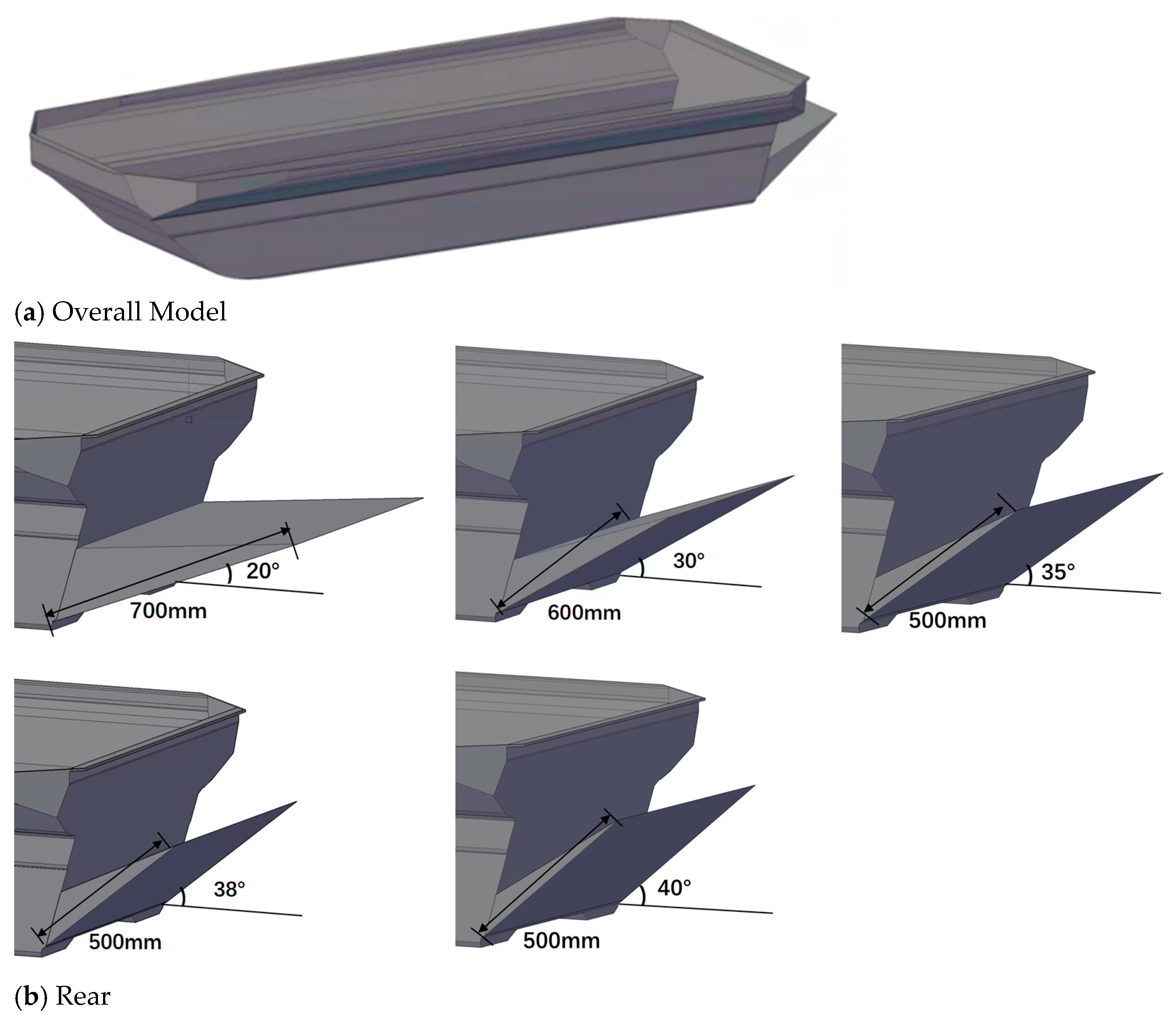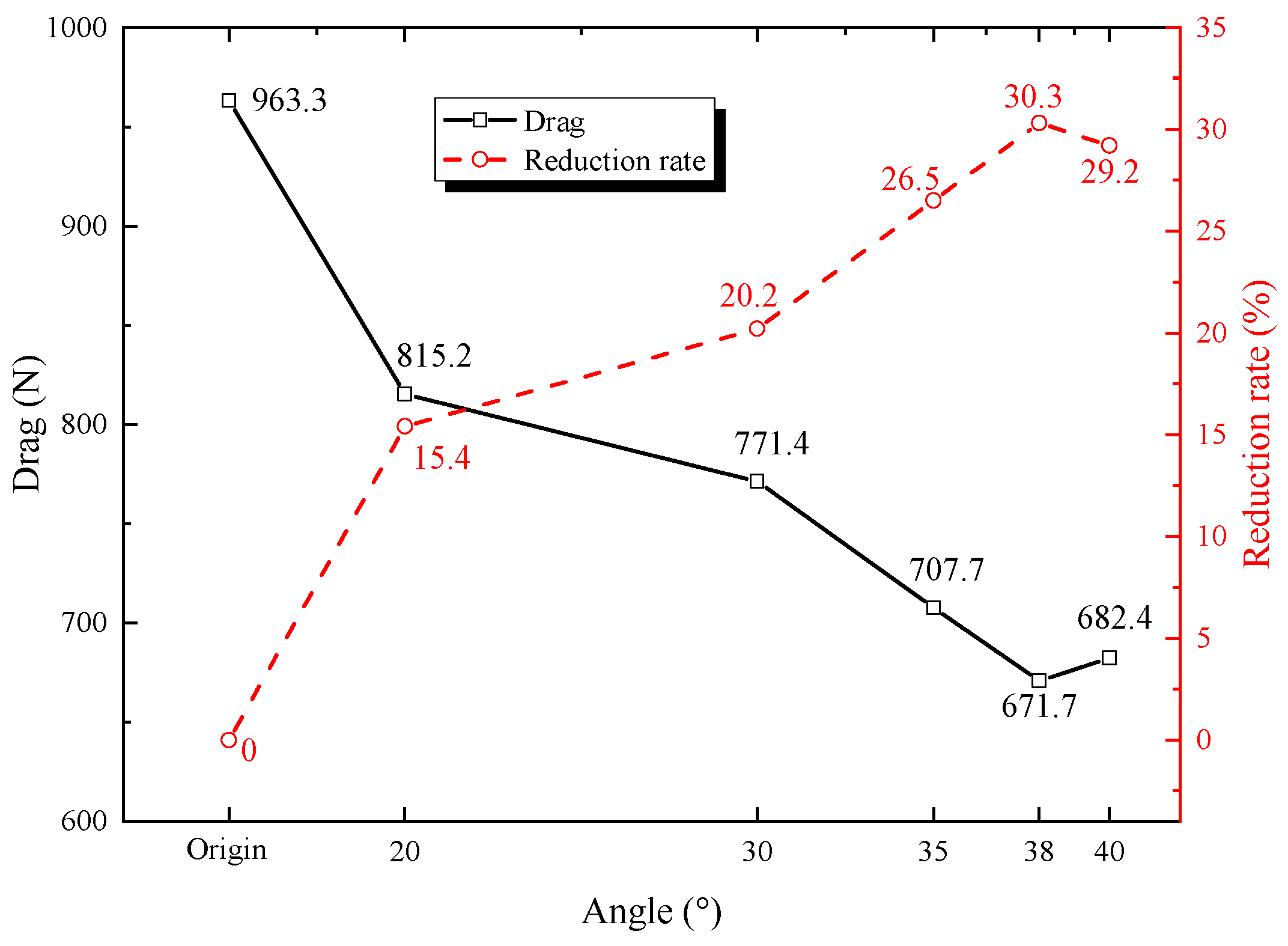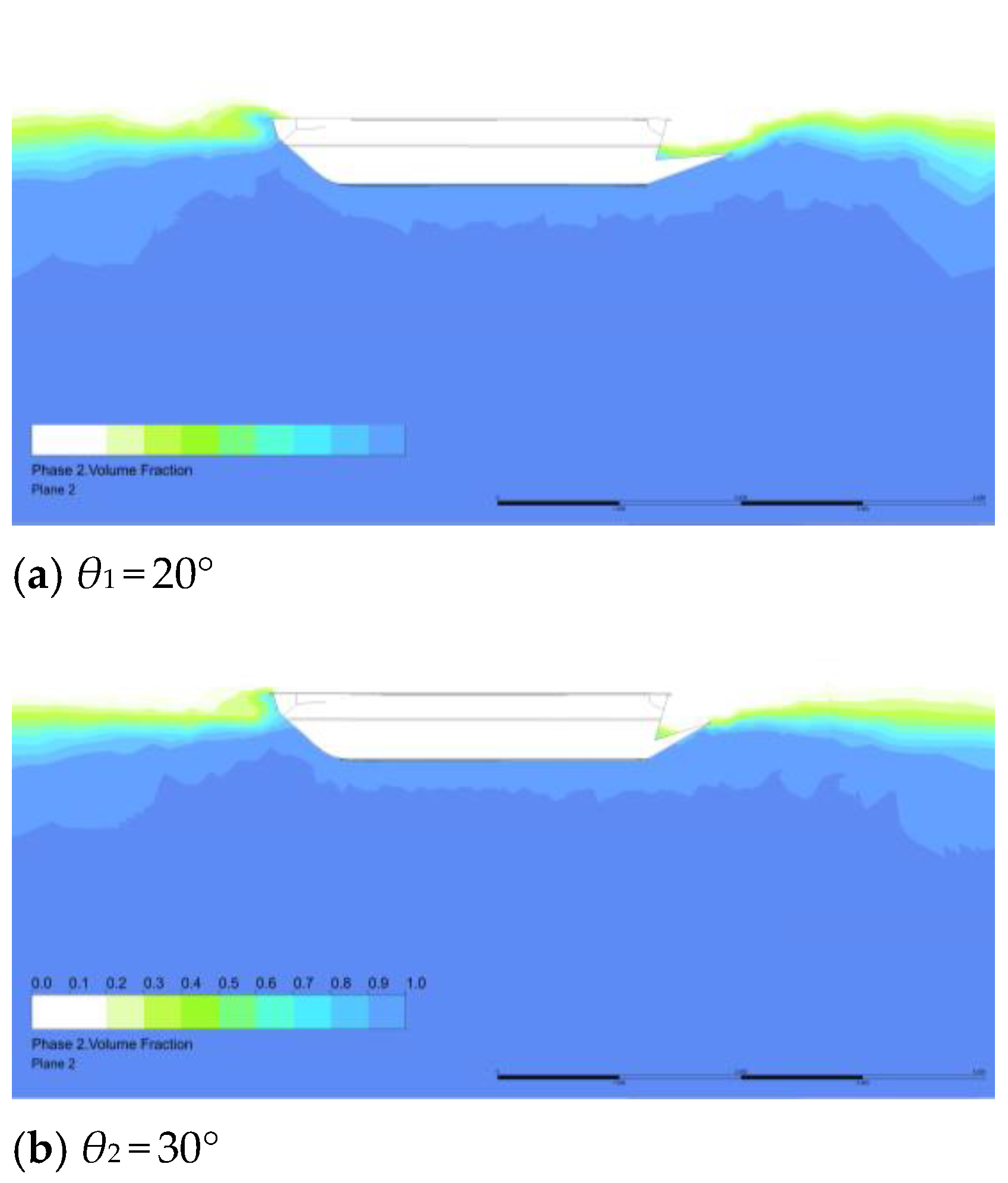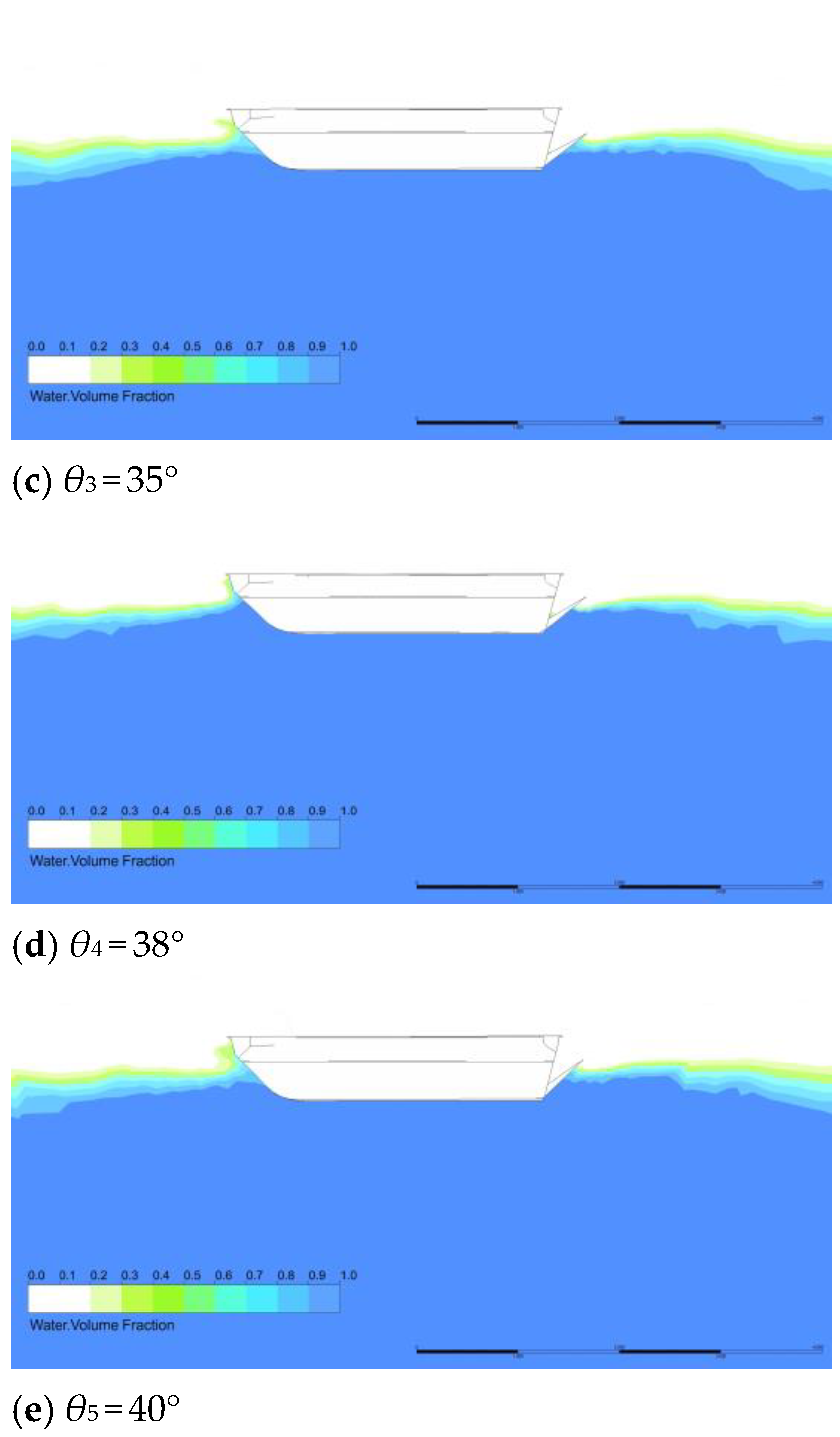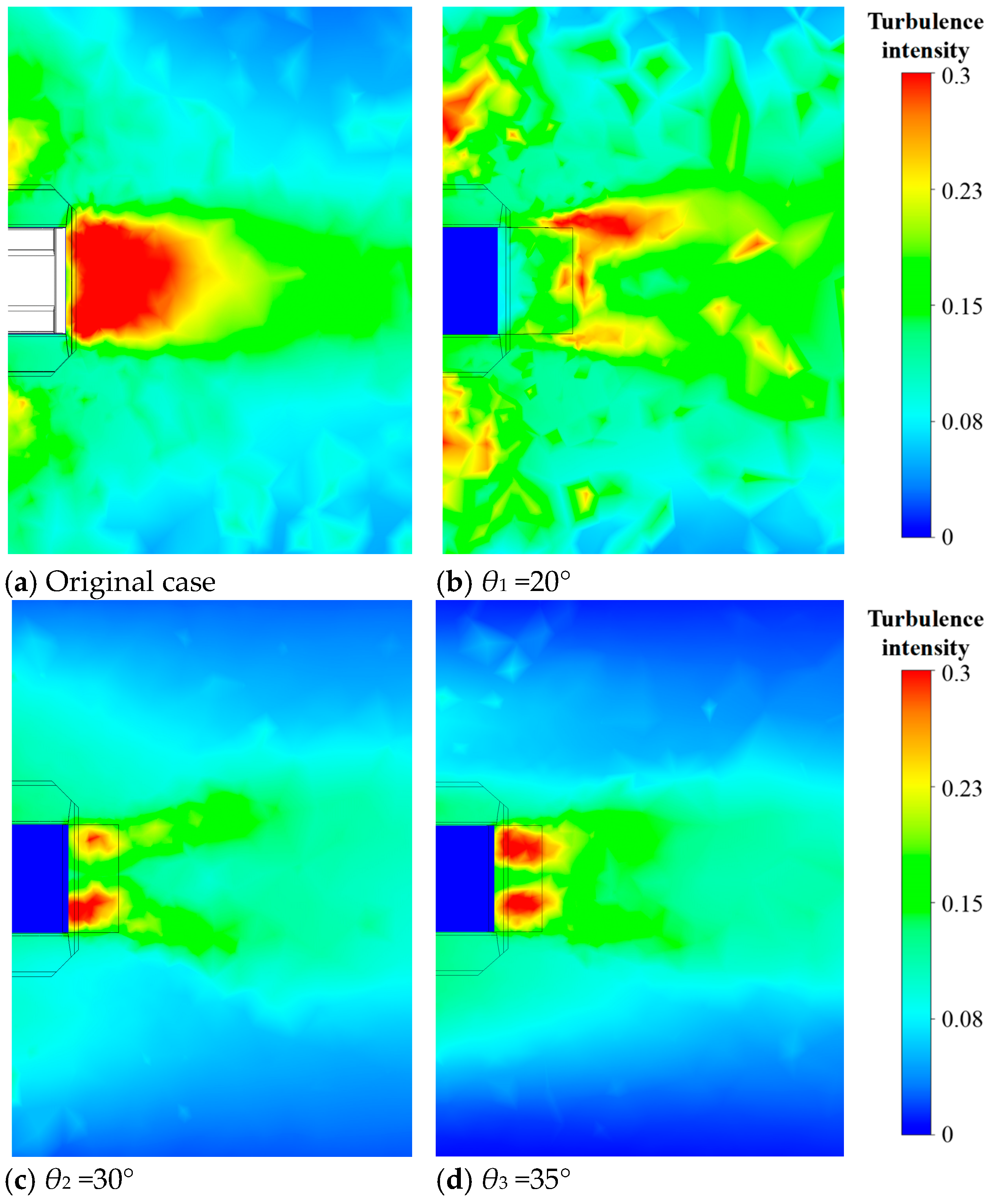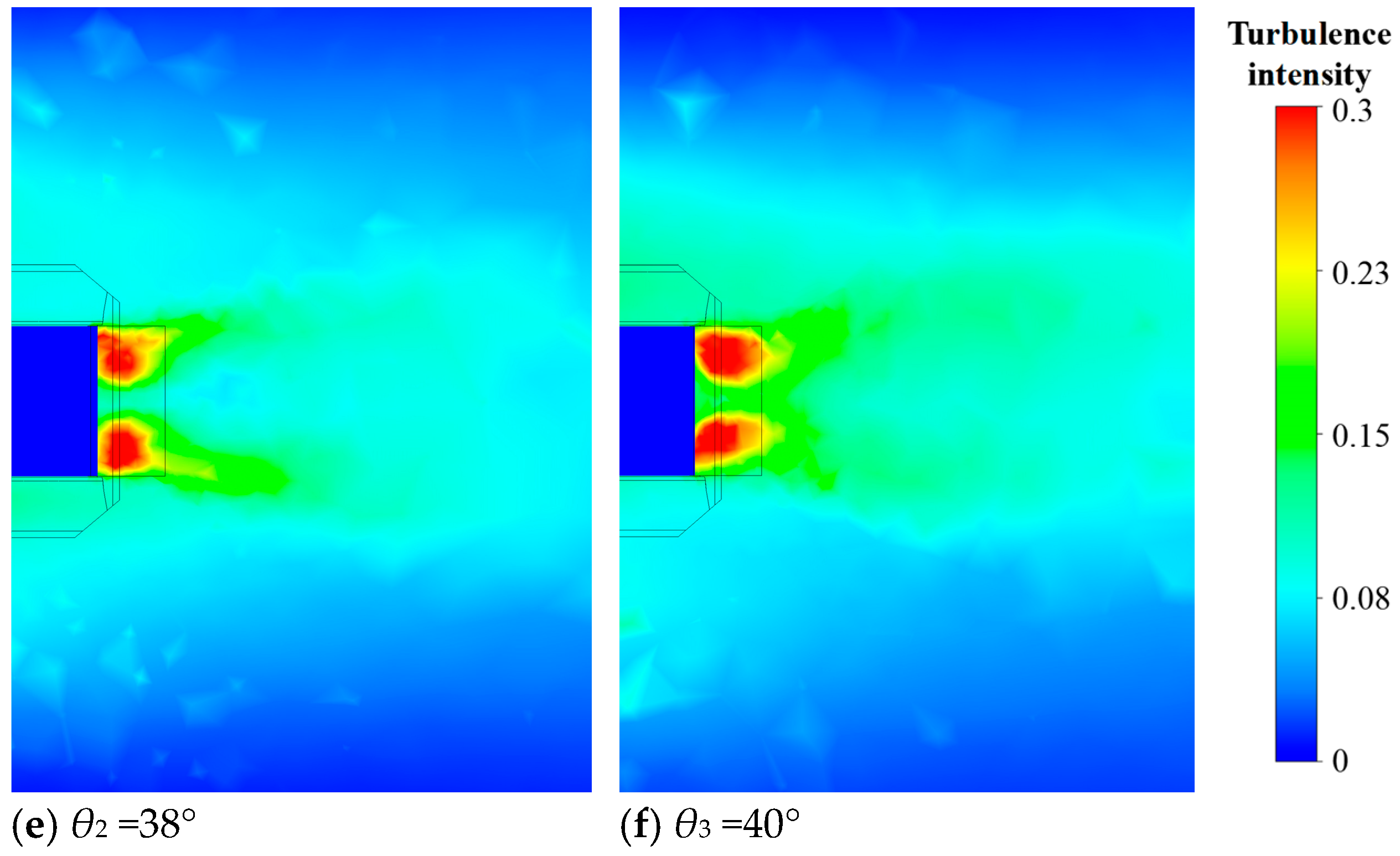1. Introduction
As special vehicles with the ability to move on both land and water, amphibious vehicles have gradually become important civilian and military equipment to respond to various natural disasters, emergencies, military missions, and so on [
1]. Because of the complexity of the movement mechanism and control system of amphibious vehicles, many amphibious vehicles are designed to ensure land maneuverability while ignoring their water navigation performance. For example, subject to the land traveling limitations of the vehicles, discontinuous protruding or concave positions exist on the surface of amphibious vehicles, which complicates their hydrodynamic performance [
2]. Generally speaking, amphibious vehicles belong to blunt body structures with poor streamlining, and there is a problem of high resistance when traveling in water [
3]. The resistance of amphibious vehicles is the key factor determining their transportation efficiency and energy consumption. Lower resistance means higher maximum speed, better water mobility, and lower energy consumption. Therefore, studying the resistance characteristics of amphibious transport vehicles has important theoretical and engineering value.
Despite the absence of a well-established theoretical framework for predicting the resistance characteristics of amphibious vehicles, recent studies [
4,
5,
6,
7,
8,
9,
10,
11,
12,
13] have demonstrated that the walking mechanism design, shape optimization, and drag-reduction attachments can significantly improve resistance during navigation. For example, by employing a folding mechanism to elevate the wheels of an amphibious vehicle above the water surface, the hydrodynamic shape of the submerged part can be improved, thereby reducing navigational resistance [
4]. However, such mechanisms are complex and unsuitable for larger amphibious vehicles, as they also compromise terrestrial performance [
5]. A more direct approach to reducing drag involves altering the shape of the submerged part of the vehicle. This principle optimizes the pressure distribution over the surface of the vehicle, thereby reducing the form drag. Nakisa et al. [
6] investigated three amphibious vehicle bow shapes: U-shaped, V-shaped, and flat. Yan et al. [
7] drew inspiration from the shape characteristics of hammerhead sharks to design fairings for tracked amphibious vehicles and achieved a decrease of 22% in underwater drag. Liu et al. [
8] proposed a curved wheel groove shape and expressed its superior hydrodynamic characteristics in terms of the pressure distribution, flow field, and vehicle posture.
Drag-reduction attachments are also a common measure for reducing resistance. Common attachments for amphibious vehicles include bow plates, stern flaps, side flanks, and so on, which improve the flow field and optimize the posture. These attachments are primarily based on the more mature drag-reduction theories or technologies found in ships. However, the hull lines of amphibious vehicles are significantly different from those of ships, with amphibious vehicles being shorter, having a smaller draft, and exhibiting more pronounced shape changes [
1]. Therefore, the effectiveness of drag-reduction attachments on amphibious vehicles still requires further research. Installing a bow plate on a vehicle can effectively suppress the wave height at the bow, reducing wave resistance [
9,
10,
11]. Installing side flanks in the flow field region with the most severe pressure accumulation can significantly alter the vehicle’s pressure distribution and turbulent flow field, thereby improving hydrodynamic characteristics [
12]. Stern flaps can effectively improve navigation posture by reducing the volume and surface area of the submerged part, effectively reducing resistance [
13]. Overall, these types of attachments have also achieved good results in reducing drag for amphibious vehicles. However, due to the significant differences in the appearance of different amphibious vehicles, it is necessary to conduct more extensive research in order to summarize more common patterns.
With the continuous development of computer technology and simulation methods, numerical simulation methods based on computational fluid dynamics (CFD) have become essential for analyzing the hydrodynamic performance of amphibious vehicles. Pena and Huang [
14] reviewed the research progress of turbulence modeling strategies in ship hydrodynamic simulations. They introduced the main turbulence modeling methods and analyzed their applicability and limitations. The Reynolds-averaged Navier–Stokes (RANS) equations are highly accurate in predicting the resistance characteristics of ships. Guo et al. [
15] conducted a multiobjective optimization design of a waterjet-propelled trimaran using the RANS method. This approach can accurately predict the hydrodynamic performance of a waterjet system and clearly highlight the flow-field details. Bakica et al. [
16] focused on large container ships and cargo vessels, used RANS to conduct the self-propulsion numerical simulation of the propeller, and investigated the resistance during navigation. CFD has demonstrated good applicability in research on the navigation resistance of amphibious vehicles. More et al. [
17] conducted stability and drag analyses of a wheeled amphibious combat vehicle using a combination of model testing and numerical computation methods. Kim and Tezdogan [
18] used a full nonlinear unsteady RANS model to investigate the maneuverability of a benchmarking ship under irregular sea conditions. Villa and Brizzolara [
19] studied the hydrodynamic performance of a hydrofoil-equipped vessel with installed flaps and interceptors using numerical simulations and established a relationship between the angle of the flap and the equivalent height of the interceptors. Liu et al. [
20] evaluated the effects of stern flaps on the resistance and operational performance of an amphibious vehicle. Sun et al. [
21] designed a wave-slicing plate on the stern of a tracked amphibious vehicle and analyzed the effects of different angles and lengths of the stern wave-slicing plate on the posture and resistance performance of the vehicles. Current research findings indicate that the integration of walking mechanism design, shape optimization, and drag-reduction attachments offers promising avenues for improving the hydrodynamic performance of amphibious vehicles. With the advancement of computational methods, CFD-based simulations continue to play a crucial role in clarifying and improving the resistance characteristics of vehicles.
This study investigates the navigational performance of a novel symmetric amphibious vehicle and conducts research on drag reduction. Firstly, a numerical model for the amphibious vehicle was established based on the Reynolds-Averaged Navier–Stokes (RANS) equations and the volume-of-fluid (VOF) method, analyzing the flow field characteristics and resistance performance at different speeds. Secondly, by installing large-angled and large-sized stern flaps, drag-reduction optimization effects of different stern shapes were examined. Finally, by comparing the characteristics of the wake flow field, the drag-reduction mechanism was analyzed, the optimal angle for the stern flaps to reduce drag was obtained, and the applicability of such optimization measures was explained. The research results can provide a reference for improving the navigational performance of similar amphibious vehicles.
4. Discussion
Based on the simulation results of the original model and models with different stern planes, it is evident that a stern flap at an appropriate angle helps to reduce navigational resistance, with significant improvements in both the high-pressure area at the bow and the low-pressure area at the stern. To further elucidate the mechanism of the stern flap, explanations are provided from the perspectives of flow field characteristics and energy dissipation. In turbulence, fluid layers interfere with each other, and fluid particles exhibit irregular, random motion, accompanied by energy loss and momentum loss, which directly leads to a decrease in the pressure at the stern.
Figure 15 shows the turbulence intensity at the same horizontal cross-section under different conditions, with a distance of 0.2 m up from the bottom. It can be seen that under the original condition without a stern flap, there is a large area of high turbulence intensity at the stern, essentially covering the entire width of the stern. The source of this high turbulence is the abrupt change in the shape of the stern results in the flow separation and a wake stagnation zone. Inward fluid flow generates on both sides of the amphibious vehicle and upward deflected flow generates under the amphibious vehicle. The convergence of these flow parts and their interaction with the stagnation zone lead to intense turbulent motion, large-scale vortices and significant energy loss.
When a stern flap is installed, the large area of high turbulence is significantly reduced. At θ = 20°, there are two strip-shaped high-turbulence areas on both sides of the stern that slightly expand outward along the wake, with the decrease in the high-turbulence area in the middle of the stern. This indicates that there is still significant inward fluid flow, leading to flow separation and vortex structures on both sides of the stern. They diverge in a slender shape along the wake direction. However, the upward deflected flow from the bottom of the vehicle is well guided, reducing the high-turbulence area at the middle stern. At θ = 30~40°, there are also two strip-shaped high-turbulence areas expanding along the wake. When it is larger than 35, the high turbulence areas on both sides of the stern are inclined inward, meaning the turbulence influence on the inward flow is further reduced, and the high turbulence areas in the wake are reduced. Especially at θ = 38°, except for a small area near the stern and a short-strip expanding area of high turbulence, the turbulence intensity in most areas of the wake is less than 10%, indicating that the strong turbulence in the flow field has been well alleviated and the resistance can be restored faster.
Overall, after adding a stern flap, the turbulence intensity at the stern of the amphibious vehicle is reduced, and energy dissipation is decreased due to the good flow guidance of the stern flap, thereby reducing the navigational resistance of the amphibious vehicle. The optimal angle in this simulation is 38°. Under this condition, the high-turbulence region is mainly concentrated in both sides of the vehicle bottom and then rapidly decays. It can be inferred that the vortex scale caused by flow separation with the stern flap is smaller, and the interference on the wake is decreased.
Although the simultaneous use of wave boards and stern flaps can achieve excellent combined attachment effects, there are currently some studies that focus solely on flaps due to limitations in vehicle types and installation difficulties. Pan et al. [
22] analyzed the resistance of a 0° flap installed at different heights at the stern of amphibious vehicles and the simulation results indicated that a stern flap can effectively reduce the resistance, with the optimal drag-reduction efficiency being 12.56%. Sun et al. [
21] studied the resistance performance of a tracked amphibious vehicle and employed flaps at various angles (0–15°) and different lengths (116–176 mm). Their research pointed out that angles of 10° and 15° offered the best drag reduction at medium to high speeds but increased drag at low speeds. Therefore, the stern flap can be folded at low speeds and extended to an appropriate angle at medium to high speeds to reduce resistance. Different lengths of flaps also affect drag reduction, but the efficiency is greater than 20%, with a maximum resistance reduction of 34.31%. Actually, the commonly used flap angles are relatively small, and the drag-reduction effects vary significantly across different amphibious vehicle models. The flaps used in this work employed larger angles (20–35°) and lengths (greater than 500 mm) and under these optimized shapes still achieved a drag-reduction efficiency of over 15%, with an optimal of 30.3%, indicating that larger angles and lengths of flaps may also contribute to navigation drag reduction. Such stern flaps have a significant guiding effect on the flow field, reducing the areas of high turbulence intensity in the wake. In addition, as shown in
Figure 15, the main function of the stern flap is to reduce the upward flow from the vehicle bottom, rather than the inward flow of both sides of the vehicle body. Therefore, it can be inferred that for amphibious vehicles of different sizes, more suitable stern flaps can be selected based on the actual draft or stern size to ensure the guidance of sufficient length of wake and the alleviation of areas with high-intensity turbulence.
In practical applications, the advantage of such large-angle, large-length flaps lies in their ease of manufacturing, installation, and more precise angle adjustment and flap operation. Amphibious vehicles are often used in military action and emergency rescue, where more urgent or severe application scenarios must be considered. Under these circumstances, these types of flaps can be more quickly changed by different shapes or adjusted to another angle, and even when damaged, they can be more easily replaced by items of similar shapes. Therefore, the design of such flap attachments can provide new ideas and reference value for drag reduction in similar amphibious vehicles. It should be noted that there are some limitations in this work. The simulation did not take into account the control performance and stability of the amphibious vehicle. At higher speeds and in more complex environments, the attitude of the amphibious vehicle could change significantly, affecting the composition of the navigational resistance and the drag-reduction effect of the stern flaps. Additionally, the simulation results of this paper require validation through experiments or actual measurements. In future work, the stability and operational performance of amphibious vehicles will be taken into account, and corresponding tests will also be conducted to verify the accuracy of the simulation.
5. Conclusions
Based on the k-ω model and the VOF method, the sailing resistance of an all-terrain all-water amphibious emergency rescue vehicle was simulated numerically. The results show that (1) with an increase in sailing speed, the differential pressure resistance and resistance coefficient exhibit nonlinear and large increasing trends. At a sailing speed of 3 m/s, the drag coefficient of amphibious vehicles is 0.098, which has a large optimization space. (2) With an increase in the sailing speed, the fluid in the stern of the amphibious vehicle causes a violent flow separation and large-scale vortex, and the fluid movement in the stern is more turbulent, which is the source of the differential pressure resistance of the amphibious vehicle. (3) The flow improvement and drag-reduction optimization of the amphibious vehicle are achieved by installing a stern flap. The stern flap can effectively guide the fluid in the stern. In particular, the high-intensity turbulence in the middle of the stern, which originates from the interaction between the bottom vehicle upward deflected flow and the recirculation zone caused by flow separation, is alleviated. Therefore, the navigational resistance of the amphibious vehicle is reduced. (4) The optimized drag-reduction rate is 30.3% when a stern flap angle of 38° is adopted, which achieves a good drag-reduction effect. (5) Compared to existing work, the angle and size of stern flaps in this work are larger, making it highly applicable in specific scenarios.

